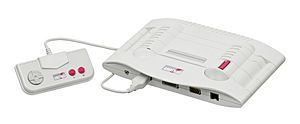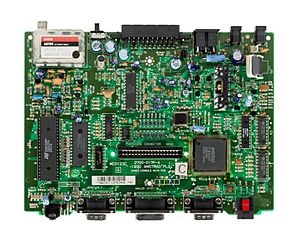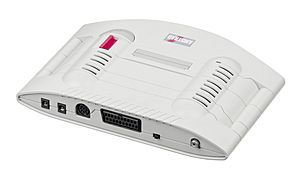Amstrad GX4000 facts for kids

An Amstrad GX4000 with its accompanying game controller
|
|
| Manufacturer | Amstrad |
|---|---|
| Type | Home video game console |
| Generation | Third generation |
| Retail availability |
|
| Discontinued | 1991 |
| Units sold | 14,000 |
| Media | ROM Cartridge |
| CPU | Zilog Z80 @ 4 MHz |
| Memory | 64 kB RAM, 16 kB VRam |
| Display | RGB and composite out; 160x200, 16 colours; 320x200, 4 colours; 640x200, 2 colours; 12-bit colour depth; |
| Graphics | ASIC |
| Sound | AY-3-8912 |
| Best-selling game | Burnin' Rubber (Pack-in) |
The GX4000 was a video game console made by a company called Amstrad. It was their try at joining the world of video games, but it didn't last very long. It came out in Europe in 1990. It was like an improved version of Amstrad's popular CPC computers.
The GX4000 used similar parts to Amstrad's CPC Plus computers, which came out at the same time. This meant it could play most of the games made for the CPC Plus computers. The GX4000 was Amstrad's first and only try at making a game console. Even though it had better graphics, it wasn't very popular and was quickly stopped. Only about 15,000 units were sold.
Launching the GX4000 Console
The GX4000 was officially announced in August 1990 in Paris. It was launched a month later in four countries: Britain, France, Spain, and Italy. In Britain, it cost about £99.99. Most games cost £25.
The console came with the racing game Burnin' Rubber, a power pack, and two controllers. Early reviews of the console were positive. A magazine called CVG said it was a "neat looking and technically impressive console." They liked the graphics but thought the sound and controllers could be better. Another magazine, ACE, agreed, saying it was better than other 8-bit systems, except for the PC-Engine.
Amstrad spent a lot of money, about £20 million, to advertise the GX4000 in Europe. The ads tried to make people think they could bring arcade games home. The slogan was "Bring the whole arcade into your home!"
Why the GX4000 Didn't Sell Well
The GX4000 was not a big success. There weren't many games for it, and new games came out slowly. People weren't very interested in it. Popular magazines didn't write much about the console.
Within a few weeks of its launch, the system was already being sold at lower prices. By July 1991, some stores were selling it for as little as £29.99. Many GX4000 games were just CPC computer games put onto cartridges. They had few or no improvements. This made people not want to buy them. Why pay £25 for a cartridge game when you could buy the same game for £3.99 on a cassette?
Amstrad couldn't compete with bigger companies like Sega and Nintendo. Sega's Mega Drive came out in Europe in November 1990, and the Super NES was also very popular. There were also problems making the game cartridges. Companies said it took months to make games instead of weeks. This meant there weren't many games ready when the console launched. Some games were even released late or cancelled.
Cliff Lawson, who designed the GX4000, said it was technically "at least as good" as the SNES. He believed it failed because it didn't have enough games. He also said Amstrad didn't have enough money to compete with Nintendo and Sega. To make it a success, he thought they needed more money to encourage game companies to support Amstrad. He also said games needed to be released faster. He even mentioned that making the console 16-bit would have helped.
Technical Details of the GX4000
The GX4000 had some interesting technical features for its time.
- CPU: 8/16-bit Zilog Z80A chip running at 4 MHz
- ASIC: This special chip helped with sprites (small moving images), smooth scrolling, and sound.
Screen Resolution
The GX4000 could show games in different resolutions:
- Mode 0: 160x200 pixels with 16 colors
- Mode 1: 320x200 pixels with 4 colors
- Mode 2: 640x200 pixels with 2 colors
Colors
- Color Depth: 12-bit RGB, meaning it could show 4096 different colors.
- Maximum Colors Onscreen: It could show up to 32 colors at once. This included 16 for the background, 15 for sprites, and 1 for the border.
- More colors could be shown using special tricks called interrupts.
Sprites
- Number: It could show 16 high-resolution sprites on each line.
- Sizes: Sprites were 16x16 pixels. They could be made 2 or 4 times bigger.
- Colors: Each sprite could use up to 15 colors.
Memory
- RAM: 64 kB (for running programs)
- VRam: 16 kB (for graphics)
- ROM: 32 kB (for system software)
Sound
- It had 3-channel stereo sound using an AY-3-8912 chip.
- It also had DMA sound, which helped with sound effects.
Input/Output (IO) Ports
The console had many ports for connecting things:
- Audio output
- Two ports for digital controllers
- One port for an analog controller (like a joystick)
- A special connector for a lightgun (RJ11)
- Audio and RGB Video output (8-pin DIN)
- Power supply sockets
Extra Devices (Peripherals)
Standard Controllers
The GX4000 controller looked like other popular gamepads from that time. These included controllers for the Master System and Nintendo Entertainment System. It had two main buttons on the pad. The pause button was on the console itself. It used a common 9-pin connector, similar to the Atari joystick port.
Analog Joysticks
The GX4000 could also use analog controllers. These were connected through a special port. However, not many games supported using these controllers.
Lightguns
The GX4000 had a special port for a lightgun. Many different lightguns were available from other companies. Some official games also supported using a lightgun. Two games, Skeet Shoot and The Enforcer, worked with a lightgun. They often came with a lightgun when you bought them.
Games for the GX4000
Almost 30 games were made and sold for the GX4000. Most of these games came from companies in the UK and France. Some well-known companies included Ocean, Titus, and Loriciels.
Some popular games included the one that came with the console, Burnin' Rubber. Other notable games were RoboCop 2, Pang, Plotting, Navy Seals, and Switchblade.
Many more games were planned, like Toki, Kick Off 2, and Out Run. But these were cancelled because the console didn't sell well. [1]
There were 25 games for the GX4000. Out of these, 13 were improved versions of games already released on the Amstrad CPC. Eight games were made only for the GX4000 and not for the Amstrad CPC. Four games were direct copies from the Amstrad CPC.
| Top - 0-9 A B C D E F G H I J K L M N O P Q R S T U V W X Y Z |
| Title | Genre(s) | Publisher(s) | Release date(s) | GX4000 version |
|---|---|---|---|---|
| Barbarian II: The Dungeon of Drax | Action | Ocean | 1990 | |
| Batman | Action | Ocean | 1990 | GX4000 enhanced |
| Burnin' Rubber | Action | Ocean | 1990 | GX4000 only |
| Copter 271 | Shooter | Loriciels | 1991 | GX4000 only |
| Crazy Cars II | Racing | Titus | 1990 | GX4000 enhanced |
| Dick Tracy | Action | Titus | 1991 | GX4000 enhanced |
| Epyx World of Sports | Sports | Epyx | 1990 | GX4000 enhanced |
| Fire & Forget II | Racing | Titus | 1990 | GX4000 enhanced |
| Klax | Puzzle | Domark | 1990 | GX4000 enhanced |
| Mystical | Action | Infogrames | 1990 | |
| Navy SEALS | Action | Ocean | 1990 | GX4000 only |
| No Exit | Fighting | Coktel Vision | 1990 | GX4000 enhanced |
| Operation Thunderbolt | Shooter | Ocean | 1990 | GX4000 enhanced |
| Pang | Shooter | Ocean | 1990 | GX4000 enhanced |
| Panza Kick Boxing | Fighting | Loriciels | 1991 | GX4000 enhanced |
| Plotting | Puzzle | Ocean | 1990 | GX4000 only |
| Pro Tennis Tour | Sports | Ubi Soft | 1990 | GX4000 enhanced |
| RoboCop 2 | Shooter | Ocean | 1990 | GX4000 only |
| Skeet Shoot | Shooter | Trojan | 1990 | GX4000 only |
| Super Pinball Magic | Pinball | Loriciels | 1991 | GX4000 enhanced |
| Switchblade | Action | Gremlin Graphics | 1990 | |
| Tennis Cup 2 | Sports | Loriciels | 1990 | GX4000 only |
| The Enforcer | Shooter | Trojan | 1990 | GX4000 only |
| Tintin on the Moon | Action | Infogrames | 1990 | |
| Wild Streets | Action | Titus | 1990 | GX4000 enhanced |
See also
 In Spanish: Amstrad GX4000 para niños
In Spanish: Amstrad GX4000 para niños





